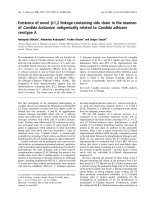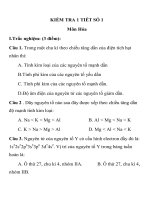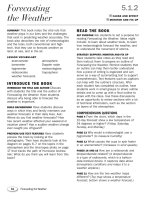Flood mapping using sentinel - 1&2 data with google earth engine cloud platform of Nghe An province, Vietnam
Bạn đang xem bản rút gọn của tài liệu. Xem và tải ngay bản đầy đủ của tài liệu tại đây (1.37 MB, 8 trang )
Science on Natural Resources and Environment 43 (2022) 28-35
Science on Natural Resources and Environment
Journal homepage: tapchikhtnmt.hunre.edu.vn
FLOOD MAPPING USING SENTINEL - 1&2 DATA WITH
GOOGLE EARTH ENGINE CLOUD PLATFORM
OF NGHE AN PROVINCE, VIETNAM
Tran Thuy Chi, Phung Thi Linh
Hanoi University of Natural Resources and Environment, Vietnam
Received 11 October 2022; Accepted 28 November 2022
Abstract
Flooding is one of the regular natural disasters in Nghe An province and thus
monitoring and assessing ood damages have been addressed by the local government
and disaster experts. However, the traditional approach to adoption is expensive and
time - consuming. In recent years, with the advances in remote sensing techniques and
the availability of free satellite data and platforms, ood damage analysis has become
easier. This study was mainly focused on ood mapping in Google Earth Engine a cloud - based analysis platform. Flood inundated map was generated using pre
and post ood images of SAR (i.e., Sentinel - 1) which provides data by continuous
observation during the ood. A land use/ land cover map was created using pre - ood
cloud - free Sentinel - 2 datasets. Flood damage was assessed by overlaying ood
inundated maps on land use/ land cover maps. Results showed that a total area of
172.43 km2 was ooded (8.71 % of lowland and coastal plain) in Nghe An province,
of which 14.39 km2 was cropland. The �ndings of this study concluded that combining
microwave and optical data for ood mapping and damage assessment in the Google
Earth Engine platform is more advantageous and cost - e cient.
Keywords: Flood mapping; Sentinel - 1; Sentinel - 2; Google Earth Engine;
Nghe An.
Corresponding author. Email:
1. Introduction
recurring oods which a�ects millions of
In central Vietnam, ooding is a people’s lives, infrastructures, economics
widespread natural disaster and recurring and local ecosystem. However, there is
event. Floods occur regularly in the rainy a lack of e�ective ood monitoring and
season, from May to the end of October, model development to monitor the impact
with high accumulated rainfall (may reach of oods.
Nowadays, researchers and agencies
up to 540 mm per month). The lowlands
near the river and sea in the east of Nghe An are enabled to utilize satellite images with
province face the risk of ooding. Rapid the development of space technology,
unplanned urbanization, climate change, which can also provide ooding periods
land use/land cover change (LULC), and extent approximately (Lamovec et
irregular rainfall are the main causes of al., 2013). Mapping ooded areas is a key
28
practice for understanding the a�ected
land use/ cover (D’Addabbo et al., 2018).
The use of optical data is di cult due
to cloud cover and accessibility of free
Synthetic Aperture Radar (SAR) data by
the European Space Agency (ESA), in a
contrast, Sentinel - 1 created an advantage
for monitoring the ood extent because
the radar sensor does not depend on
solar illumination and has the capacity
to penetrate through clouds (Uddin et al.,
2019). This information can be bene cial
for mitigation measures in times of disaster.
One of the most e�ective platforms for
cloud - based geospatial processing is
Google Earth Engine (GEE). The Google
Earth Engine, introduced by Google, Inc.,
as a new computing platform for large
- scale data processing such as the time
series data analysis of Landsat archive
(Gorelick et al., 2017) GEE platform
2. Study area
hosted a complete, up - to - date and ready
SAR data archive of Sentinel - 1A/B
Ground Range Detected (GRD) data.
In our study, we used Sentinel - 1A/B
SAR and Sentinel - 2A/B MSI datasets.
Sentinel - 2A/B MSI was used for LULC
mapping and Sentinel - 1A/B for ood
and ood-a�ected croplands mapping
and monitoring. The capability of SAR
sensors to identify ood extent and
a�ected croplands depends on various
scattering mechanisms.
The objective of this study is to
process and analyze
ooded areas
during the 2019 ood event in Nghe
An Province. Satellite imageries during
August - September 2019 were used for
investigating pre - ood and ood areas
and then subtracting the ooded layer
from the pre - ood layer in the GEE
platform.
Figure 1: Location of study area - Nghe An province
29
Nghe An province lies between
18 33’ and 20o01’ North latitude and from
103o52’ to 105o48’ East longitude, which is
in the center of the northern part of Central
Vietnam. It is located between Thanh Hoa
and Ha Tinh, bordered to the West by
Laos and to the East by the East Sea. It is
Vietnam’s largest province with complex
and diversi ed topography including
seas, plains, midlands and mountains.
Nghe An has 7 river basins (with separate
estuaries) with the total length of the river
being 9,828 km, the average density is
0,7 km/km2 and the largest river is the Ca
(the Lam River). The agricultural land
accounts for 1,238,315.48 hectares, of
which farming land is 256,834.9 hectares,
forest land 972,910.52 hectares, land for
aquaculture 7,457.5 hectares, land for salt
production 837.98 hectares, land for other
agricultural purposes 265.58 hectares,
non-agricultural land 124,653.12 hectares,
not - yet - used land 286,056.4 hectares.
Nghe An has a city, 3 towns and
17 districts, of which Vinh city is the
economic and cultural center of the
province and of the North Central region.
The average temperature ranges around
23 oC and 24,2 oC. The annual rainfall is
1,200 - 2,000 mm. The average humidity
uctuates between 80 % and 90 %. The
province receives an annual average of
1,460 sunshine hours. With more than
3,1 million people, Nghe An is Vietnam’s
fourth largest province in the population
(Nghe An Portal, n.d.)
o
) was used.
The Sentinel - 1 data has a frequency of
12 days with one satellite and 06 days with
two satellites. It is available in four modes,
which are Stripmap (SM), Interferometric
Wide swath (IW), Extra - Wide swath (EW)
and Wave (WV) while more descriptions
are available (Torres et al., 2012). The IW
mode has been used in our study which
is the main acquisition mode for the land
surface that meets contemporary service
requirements with long - term archives
(Torres et al., 2012). Its con ict - free
modes with VV + VH (vertical transmit,
vertical receive (VV) and vertical transmit,
horizontal receive (VH) polarization.
The Sentinel - 1 dataset is hosted
on the GEE platform and the available
tool of the SNAP software package was
used for pre - processing. The GEE
platform has been used to perform all
the tasks required for SAR satellite data
processing. The GEE platform was also
used to execute orbit correction, noise
removal, radiometric calibration and
terrain corrections using SRTM data and
converted backscatter intensity to decibels
(dB) according to
(1)
We used all the available Sentinel
- 1 SAR imageries for ood mapping,
monitoring and ood - a�ected cropland,
the pre - ood period (15th to 22nd August
2019) and the peak ood period (02nd to
03rd September 2019).
ESA’s Sentinel - 2A/B MSI satellite
data are capable of monitoring land
3.1. Data
surface conditions. Its revisit time is 10
In this study, we used Sentinel - 1,
Sentinel - 2 and SRTM satellite datasets. days with one satellite and 5 days with
Freely available Sentinel - 1A/B SAR two satellites. Its spatial resolution is 10
C - band (5.4 GHz) data provided by the m (bands: 2, 3, 4 and 8), 20 m (bands: 5,
European Space Agency (ESA) (SciHub; 6, 7, 8a 11 and 12) and 60 m (bands: 1, 9
3. Data and methodology
30
and 10). In this study, we used bands 2, 3,
4 and 8 of Sentinel - 2A/B MSI satellite
data for LU/LC mapping. We selected
images from March 2020 for the least
cloud cover (10 % cloud cover) using the
“CLOUDY_PIXEL_PERCENTAGE”
tool of GEE. Further, the QA band of
Sentinel - 2 was used to remove cloud
cover (Kumar et al., 2022).
Finally, all the available images
were used for LU/LC mapping of Nghe
An province in 2019. Sentinel - 2 MSI
based Land Use/Land Cover was used to
assume the impact of ood inundation on
LU/LC, especially on cropland.
3.2. Methodology
Sentinel - 1 SAR data was used
to identify the ood extent and ood a�ected rice elds. LU/LC map has been
generated using Sentinel - 2A/B MSI data
to extract ood - a�ected cropland, pre ood waterbodies and other classes. We
used the thresholding method to extract
inundated pixels. The intensity within the
threshold range was classi ed as ood,
while the pixels with intensity above the
threshold were classi ed as non - ooding.
Then, the obtained ood extent has been
subtracted by the pre - ood layer of water
bodies derived from the LU/LC layer for
the elimination of water bodies (Figure 2).
Figure 2: Flow diagram indicating the methodology of the study
The entire analysis has been
performed in the GEE cloud platform,
then a web - based IDE code has
been developed by JavaScript code
( h t t p s :/ / c o d e . e a r t h en g i n e .g o o g l e .
com/646b8312fea683781c28ee923fd4
d00f) to estimate ooded areas and ood
- a�ected cropland (Figure 3). Finally,
the inundation layer obtained was re ned
using open - source GIS tools.
31
Figure 3: Google Earth Engine Interface
4. Result and discussion
with Station (CHIRPS) data (Figure 4).
Based on the rainfall data, pre and post
4.1. Flood inundation map
ood datasets were selected from Sentinel
The cause of the ood was due
to excessive and continuous rainfall - 1. Therefore, a ood inundated map was
2
from 29th August 2019 to 5th September built and a total area of 172.43 km (i.e.,
2019 which was obtained from Climate 8.71 % of lowland and coastal plain) was
Hazards Group InfraRed Precipitation
ooded (Figure 5).
Figure 4: Rainfall data during August 29th - September 5th 2019
32
Figure 5: Flooded inundation map in Nghe An province
4.2. Land use/ land cover map and ood damage assessment
LULC map was developed to estimate damage initially using a mosaic of Sentinel
- 2 pre - ood datasets (Figure 6).
Figure 6: Land use/ land cover map of Nghe An Province in 2019
33
The a�ected LULC classes were extracted from the ood map derived from the
Sentinel - 1 dataset. The a�ected areas were urban area (6156 ha), cropland area (1439
ha) and mainly located in the Southern - East of the province (Figure 7).
Figure 7: A ected land use the land cover map
5. Conclusion
A web - based JavaScript code was
developed to process huge datasets hosted
on the GEE platform within a minute for
robust ood mapping, monitoring and
estimation of ood - a�ected cropland
using SAR imagery at a large scale with
all - weather capability. We observed the
concurrent oods (August - September
2019) in Nghe An province and found
that about 8.71 % of the lowland and
coastal plain (172.43 km2) area were
ooded, a�ecting about 5,803 persons.
The severely ood - a�ected cropland
was about 1439 ha. The ndings of
this study are useful for policymakers
and preventive measures for disaster
management. Moreover, GEE has been
shown to be a very useful tool in preparing
an emergency response related to oods
and evaluating the damaged area.
REFERENCES
[1]. D’Addabbo, A., Re ce, A.,
Lovergine, F. P., & Pasquariello, G. (2018).
34
DAFNE: A Matlab toolbox for Bayesian
multi - source remote sensing and ancillary
data fusion, with application to ood
mapping. Computers and Geosciences,
112, 64 - 75. />cageo.2017.12.005.
[2]. Gorelick, N., Hancher, M., Dixon,
M., Ilyushchenko, S., Thau, D., & Moore,
R. (2017). Google Earth Engine: Planetary
- scale geospatial analysis for everyone.
Remote Sensing of Environment, 202, 18 27. />[3]. Ke , M., Mishra, B. K., & Kumar,
P. (2018). Assessment of Tangible Direct
Flood Damage Using a Spatial Analysis
Approach under the E ects of Climate
Change: Case Study in an Urban Watershed
in Hanoi, Vietnam. International Journal of
Geo - Information. />ijgi7010029.
[4]. Kumar, H., Karwariya, S. K., &
Kumar, R. (2022). Google Earth Engine based identi�cation of ood extent and ood
- a ected paddy rice �elds using Sentinel
- 2 MSI and Sentinel - 1 SAR Data in Bihar
State, India. Journal of the Indian Society of
Remote Sensing, 50(5), 791 - 803. https://doi.
org/10.1007/s12524-021-01487-3.
[5]. Lamovec, P., Matjaž, M., & Oštir,
K. (2013). Detection of ooded areas using
Machine Learning Techniques: Case study of
the Ljubljana Moor oods in 2010. Stochastic
rainfall models for rainfall erosivity evaluation
View project Erosional processes on coastal
ysch cli�s and their risk assessment, ARRS
J1-2477 research project View project. In
Disaster Advances (Vol. 6, Issue 7). http://
www.disasterscharter.org/home.
[6]. Nghe An Portal. (n.d.) (2022).
Overview of Nghe An province. Retrieved
September 27, 2022. .
vn/wps/portal/na_english/.
[7]. Nguyen Y Nhu, Dang Dinh Kha,
Nguyen Quang Hung, Dao Thi Hong Van,
Trinh Minh Ngoc, Ngo Chi Tuan (2021). Earth
and Environmental sciences. VNU Journal of
Science, vol. 37, no. 3, p. 21 - 26. https://doi.
org/10.25073/2588-1094/vnuees.4678.
[8]. Pandey, A. C.; Kaushik, K.;
Parida, B. R. (2022). Google Earth Engine
for large - scale ood mapping using SAR
Data and Impact assessment on agriculture
and population of Ganga - Brahmaputra
basin. Sustainability 14, 4210. https:// doi.
org/10.3390/su14074210.
[9]. Torres, R., Snoeij, P., Geudtner, D.,
Bibby, D., Davidson, M., Attema, E., Potin,
P., Rommen, B. Ö., Floury, N., Brown, M.,
Traver, I. N., Deghaye, P., Duesmann, B.,
Rosich, B., Miranda, N., Bruno, C., L’Abbate,
M., Croci, R., Pietropaolo, A., Rostan, F.
(2012). GMES Sentinel - 1 mission. Remote
Sensing of Environment, 120, 9 - 24. https://
doi.org/10.1016/j.rse.2011.05.028.
[10]. Uddin, K., Matin, M. A., & Meyer,
F. J. (2019). Operational ood mapping using
multi - temporal Sentinel - 1 SAR images: A
case study from Bangladesh. Remote Sensing,
11(13). />
35









